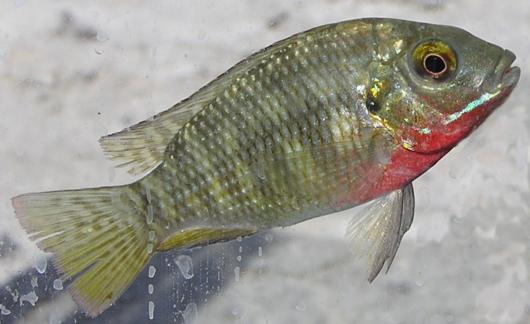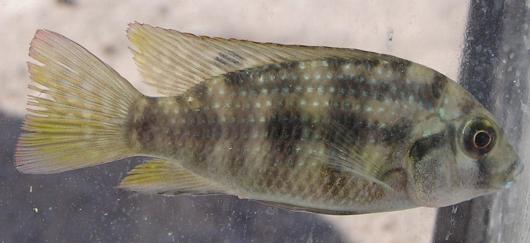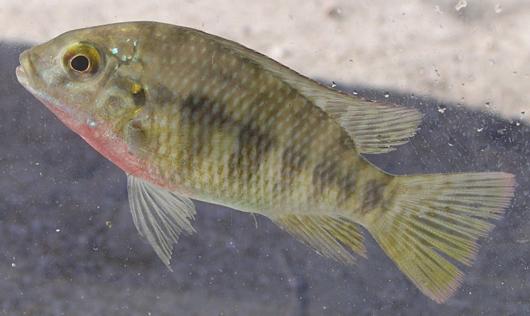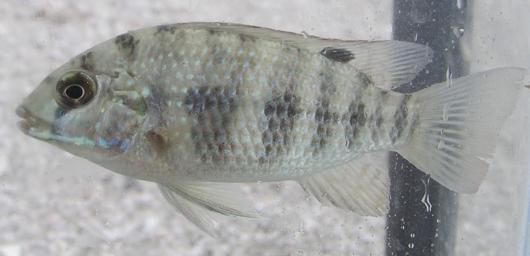Redbelly Tilapia
-
Scientific NameTilapia zillii
-
NativeNon-Native
-
Identification
 Redbelly tilapia, spawning colors. Location: Arthur 0.5 Drain, Salton Sea. Date: Oct. 28, 2010. Photo by Sharon Keeney, California Department of Fish and Game.
Redbelly tilapia, spawning colors. Location: Arthur 0.5 Drain, Salton Sea. Date: Oct. 28, 2010. Photo by Sharon Keeney, California Department of Fish and Game. Redbelly tilapia, non-spawning colors. Location: Arthur 0.5 Drain, Salton Sea. Date: Oct. 28, 2010. Photo by Sharon Keeney, California Department of Fish and Game.
Redbelly tilapia, non-spawning colors. Location: Arthur 0.5 Drain, Salton Sea. Date: Oct. 28, 2010. Photo by Sharon Keeney, California Department of Fish and Game. Redbelly tilapia, spawning colors (left side). Location: Arthur 0.5 Drain, Salton Sea. Date: Oct. 28, 2010. Photo by Sharon Keeney, California Department of Fish and Game.
Redbelly tilapia, spawning colors (left side). Location: Arthur 0.5 Drain, Salton Sea. Date: Oct. 28, 2010. Photo by Sharon Keeney, California Department of Fish and Game. Redbelly tilapia, non-spawning colors (left side). Location: Oasis-Grant Drain, Salton Sea. Date: Oct. 25, 2010. Photo by Sharon Keeney, California Department of Fish and Game.
Redbelly tilapia, non-spawning colors (left side). Location: Oasis-Grant Drain, Salton Sea. Date: Oct. 25, 2010. Photo by Sharon Keeney, California Department of Fish and Game.- Deep, elongate, laterally compressed body with the head wider than the rest of the body
- Nearly horizontal mouth
- Normally dark olive on back, light olive or brown sides, a yellow to white belly, and brown to yellow fins
- Sides often have an iridescent sheen and 6-7 poorly defined vertical bars
- Both the operculum and dorsal fin have a dark spot. The dorsal fin’s spot is often outlined in yellow and surrounded by smaller yellow spots
- Spawning fish become a shiny dark green on the back and sides with a bright red throat and belly, distinct vertical bands on the side, and mottled blue-green spots over a dark blue-black head
- 14-16 spinesand 10-13 rays in the long dorsal fin, many of the rays are longer than the spines
- 3-4 spines and 7-10 rays in the anal fin
- 14-15 rays in the pectoral fins
- Rounded caudal fin
- 28-30 cycloid scales on the lateral line
-
Life History
Redbelly tilapia are naturally found in large lakes and rivers but have successfully invaded a variety of ponds, irrigation ditches, and other artificial habitats. In California this is especially true in the warm, saline, irrigation return waters of the Imperial Valley. They have been found in salinities of 29-35 ppt and temperatures as high as 38°C. Low temperatures seem to be a restraint however as temperatures below 13°C are usually lethal and reproduction can not happen below 20°C. Aquatic plants and algae make up the majority of their diet and their teeth are designed for optimum foraging of these materials. Despite this adaptation tilapia will still eat invertebrates, often when found on aquatic vegetation, and even fish provided they are dead or dying. The young also feed substantially on crustaceans for the first few months of life.
Mating begins whenever waters are above 20°C, which in Southern California is about 6 months of the year. Redbelly tilapia will look for shallow, protected areas with bottoms of rock, sand, or mud, but prefer a softer substrate to dig their nests into. They breed in circular colonies with the outer fish providing a line of protection for those inside of the circle. Spawning occurs when a mating pair is formed and a nest is built into the substrate. The female will then lay her 1,000-6,000 eggs inside the nest for the male to fertilize. Both parents will care for the embryos by fanning water across the eggs to increase oxygen intake, removing debris from the nest, and blocking the entrance with their bodies as protection from predators. The embryos hatch in 2-3 days and the young are then transferred by mouth or fin fanning to a nearby depression for 3-4 days until their yolk sac is absorbed and they become free swimming. Adults can mate again in a month and can continue to do so as long as conditions are acceptable. In California this usually means between 4 and 6 broods a season. Growth for young tilapia is very dependent on the size of their population. In low densities like those found in irrigation ditches they can grow as much as 17 cm in first year but tilapia found in crowded ponds can take as long as 2 years to reach a length of only 7 cm. Redbelly tilapia normally measure 13-14 cm TL before breeding, but may mature at smaller sizes in Imperial Valley ditches and Coachella Valley ditches.
-
Links to Other ResearchN / A
-
WatershedN / A
Please note, watersheds are at the USGS 8-digit Hydrologic Unit Code (HUC) scale, so they often include a lot of sub-watersheds. If a species occurs in any sub-watershed within the HUC, the species appears within the HUC. Link to an EPA page that shows HUCs.



